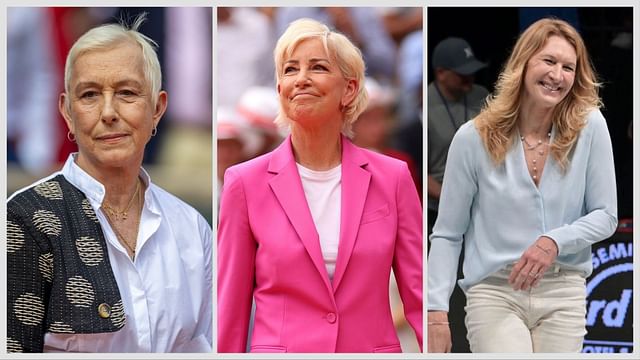
Steffi Graf, Martina Navratilova, and Chris Evert dominated the world of tennis and etched their names in history as three of the greatest athletes of all time through their individual accolades and records. All three are in the International Tennis Hall of Fame and have a range of records and accomplishments to their names.
Graf’s reign came a little after Navratilova and Evert’s rivalry, but owing to the stature they have earned for themselves, their names are taken together as much as they are discussed individually. The German retired in 1999 with 22 majors, the third-most to be won by a tennis player. Navratilova retired with 18 major singles titles in 1994. Similarly, at a tie with her arch-rival, Evert retired in 1989 with 18 Grand Slams titles.
Tennis, a sport known for its grace, strategy, and athleticism, has been shaped by numerous remarkable players over the decades. Among the pantheon of tennis legends, three names stand out: Steffi Graf, Martina Navratilova, and Chris Evert. Their careers not only define an era in women’s tennis but also serve as benchmarks for excellence in the sport. Each of these athletes carved out a unique path, and together, they forged a narrative that transformed women’s tennis into a global spectacle.
Chris Evert and Martina Navratilova emerged as dominant forces in the 1970s and 1980s, engaging in one of the most storied rivalries in sports history. Evert, known for her baseline consistency and mental toughness, turned professional in 1972. Her graceful playing style and relentless focus quickly made her a fan favorite. She captured her first Grand Slam title at the 1974 French Open and established herself as a perennial contender in all major tournaments.
Navratilova, a fierce competitor and one of the first athletes to adopt a serve-and-volley style in women’s tennis, began her professional career shortly after Evert’s ascent. The two players’ contrasting styles led to an intense rivalry that spanned nearly two decades. Their matches were often marked by high drama and showcased the evolution of women’s tennis. Navratilova’s aggressive play complemented Evert’s strategic approach, creating a captivating dynamic that attracted fans worldwide.
The 1980s belonged to Evert and Navratilova, with each player exchanging the world No. 1 ranking multiple times. Evert’s 18 Grand Slam singles titles, achieved through her remarkable consistency, placed her at the pinnacle of the sport. Meanwhile, Navratilova, with her 18 major singles titles, revolutionized the game with her athleticism and powerful serve. Their rivalry culminated in 80 matches, with Navratilova narrowly leading their head-to-head record.
In this era, the tennis landscape began to change as media coverage expanded, and the sport gained increased popularity. Both players became household names, not just for their on-court prowess but also for their influence on women’s sports. They paved the way for future generations, showing that female athletes could achieve greatness and garner significant recognition.
As Evert and Navratilova were defining women’s tennis, Steffi Graf emerged in the late 1980s, introducing a new level of athleticism and skill. Graf turned professional in 1982 and quickly made a name for herself with her powerful forehand and exceptional footwork. She won her first major title at the 1987 French Open, marking the beginning of a remarkable career that would ultimately see her retire with 22 Grand Slam singles titles—the most of any player at the time.
Graf’s playing style was characterized by her aggressive baseline game and ability to dominate matches with her powerful shots. Her breakthrough year came in 1988 when she achieved the unprecedented “Golden Slam,” winning all four Grand Slam titles and the Olympic gold medal in the same calendar year. This feat solidified her status as one of the greatest players in the history of the sport.
While their careers overlapped, the impact of Graf, Evert, and Navratilova extended beyond their head-to-head matches. Each player contributed to the sport’s evolution in different ways. Evert’s emphasis on technique and consistency influenced the next generation of players, while Navratilova broke barriers regarding fitness and training regimens in women’s sports. Graf’s power game shifted the dynamics of women’s tennis, inspiring young athletes to embrace a more aggressive playing style.
Their induction into the International Tennis Hall of Fame underscores their extraordinary achievements and contributions to the sport. In addition to their Grand Slam titles, each player set numerous records that remain benchmarks today. Evert was the first woman to earn over $10 million in prize money, while Navratilova’s 9 Wimbledon singles titles and Graf’s 377 weeks at No. 1 highlight their dominance in tennis history.
Even after their retirements, Graf, Evert, and Navratilova continued to shape the sport. They have engaged in philanthropic efforts, championing women’s sports and advocating for equal pay and opportunities for female athletes. Their influence extends beyond tennis, as they have become ambassadors for the sport, inspiring countless young players to pursue their dreams.
In contemporary tennis, the impact of these legends is evident. Players like Serena Williams and Venus Williams, who have dominated the sport in recent years, often cite Evert, Navratilova, and Graf as their inspirations. The standards they set in terms of professionalism, athleticism, and competitiveness continue to resonate in the modern games.
Steffi Graf, Martina Navratilova, and Chris Evert not only dominated the world of tennis during their careers but also laid the groundwork for future generations. Their legacies are interwoven with the history of the sport, and their contributions continue to inspire athletes around the globe. As the world of tennis evolves, the names of these three icons will forever be associated with excellence, resilience, and the relentless pursuit of greatness in the game they love. Their stories remind us that the journey of a champion is paved with determination, skill, and an enduring passion for the sport.